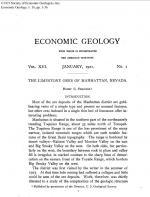Добрый день, Коллеги. Важное сообщение, просьба принять участие. Музей Ферсмана ищет помощь для реставрационных работ в помещении. Подробности по ссылке
The limestone ores of Manhattan, Nevada
Most of the ore deposits of the Manhattan district are gold-bearing veins of a simple type and present no unusual features, but other ores inclosed in a single thin bed of limestone offer interesting problems.
Manhattan is situated in the southern part of the northeasterly trending Toquima Range, about 35 miles north of Tonopah. The Toquima Range is one of the less prominent of the many narrow, isolated mountain ranges which are such notable features of the Great Basin topography. The range is bordered by desert valleys—Ralston Valley and Monitor Valley on the east and Big Smoky Valley on the west. On both sides, but particularly on the west, the boundary between rock in place and valley fill is irregular, in marked contrast to the sharp lines of demarcation on the eastern front of the Toyabe Range, which borders Big Smoky Valley on the west.
The district was first visited by the writer in the summer of 1915. At that time lode mining had suffered a collapse and little could be seen of the ore deposits. Work, therefore, was chiefly directed to a study df the complexities of the geologic structure and observations on the placers.2 The district was revisited in 1919 and the geology of the principal deposits studied in some detail; another short visit made in June, 1920. The writer desires to acknowledge the courtesies extended to him by all the mining men of the district. The detailed geologic maps of the surface geology and underground workings of the White Caps mine, made by Messrs. O. McCraney and J. L. Dynan, were of especial value. The writer gratefully acknowledges the assistance in criticisms and helpful suggestions from his colleagues, particularly A. C. Spencer and W. T. Schaller.
The ore deposits of the present Manhattan district date from April, 1905, when "specimen ore" was discovered by John C. Humphrey on April Fool Hill. An old mine about 4 miles south of the present town of Manhattan had, however, been worked in the late sixties. The discoveries of rich surface ore with plentiful free gold were made within a few hundred feet of the road leading west from the old camp at Belmont. That such ore1 should be passed unnoticed for 40 years must be attributed to the inconspicuous croppings which characterize the later discovered deposits.
During 1906 the district was in a state of excitement and rich discoveries were constantly being reported. The winter of 1907-8 was marked by depression following the deflation of the boom, but the hard times, which led to temporary cessation of quartz mining, turned the attention of the miners to the placers of Manhattan Gulch. For several years lode mining was conducted spasmodically, and generally the placer output exceeded that of the lode mines. The best placer ground has, however, been exhausted since 1915, and since that time the lode output has been the more important. In 1917 the discovery of rich ore in the lower levels of the White Caps mine led to another boom, which, though short lived, led to a considerable amount of exploratory work. At the present time a small amount of exploration work is being carried on, but the production is principally from the shallow surface workings of lessees.




